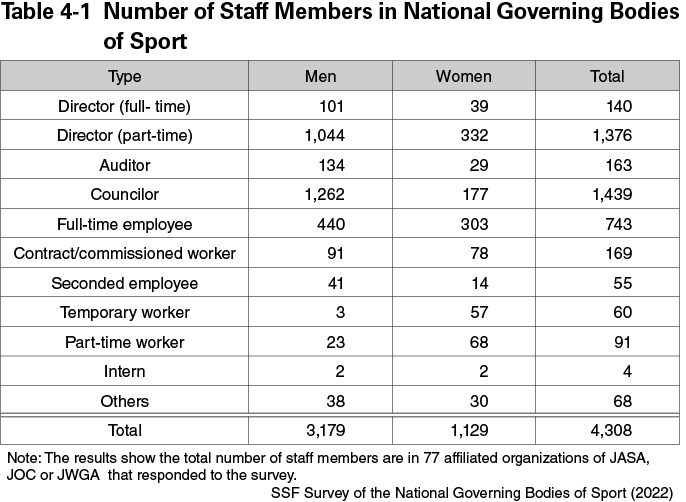This article highlights the following points;
1. Human Resources in Local Sport Administration
2. Human Resources in Sport Organizations
We use cookies to optimize and continuously improve our website for individual users. By closing this banner or continuing to view the website, you are agreeing to the use of cookies for this purpose, as detailed in our Privacy Policy.
This article highlights the following points;
1. Human Resources in Local Sport Administration
2. Human Resources in Sport Organizations
Sport administration in prefectures and municipalities has mainly been governed by the local Boards of Education, pursuant to Article 23 and 24-2 of the “Act on the Organization and Operation of Local Educational Administration” enacted in 1956. However, after the revision of the Act in 2007, many local governments transferred the responsibilities of sport administration to their own jurisdiction. According to the “SSF All Municipalities Survey on Sports Promotion” (2016), as of 2015 the sport administration department was located within the governor’s office for 44.7% of the 47 prefectures and within the mayor’s office for 15.2% of the 1,188 municipalities that responded to that survey. In the 2010 survey, these numbers were 17.0% for the 47 prefectures and 8.3% for the 1,236 municipalities. Sport administration offices governed by local governments are often referred to as Sports Promotion Division or Health and Physical Education Division, depending on the municipality.
The survey revealed that 24.8 people on average were employed fulltime in the sport administration departments in prefectures, with 6.5 people assigned to “lifelong sports”, 7.3 people to “high performance sports” and 1.9 to “para-sports”. The average for the 1,188 municipalities was 4.6 people, of which 3.4 people were assigned to “lifelong sports”, 2.8 people to “high performance sports” and 1.6 to “para-sports”. That makeup differs from prefectures as the number of people for “lifelong sports” exceeds that for “high performance sports”. Although the total number of employees expands as the population size of a municipality increases, “lifelong sports” always has most employees, followed by “high performance sports” then “para-sports”. For municipalities with small populations, it is possible that a small number of employees are working in multiple areas simultaneously.
In addition to staff members who are in charge of sport administration in local governments, employees in affiliated organizations (such as Sports Promotion Foundations and Sports Associations) of other prefectures or municipalities engage in a variety of sports promotion activities within the local government.
There are various sport organizations across Japan. With a few exceptions, the national governing bodies of sport (NGBs) serve as the main administering body of each sport, and have a number of affiliated organizations including prefectural associations. To understand the current number of staff members in NGBs who are engaged in the promotion of each sport, the results of the “SSF Survey of the National Governing Bodies of Sport” (2022) were examined. The subjects of the survey were 93 sports organizations that were affiliated organizations of either Japan Sport Association (JSPO), Japanese Olympic Committee (JOC) or Japan World Games Association (JWGA).
Staff members in National Governing Bodies of Sport (NGBs)
NGBs were asked for the number of staff members in each of the following positions: directors (full-time and part-time), auditors, councilors, regular employees, contract/commissioned workers, seconded employee (from sponsor companies, etc.), temporary workers, part-time workers, interns and others. The total number of staff members in the 77 organizations that responded to the survey was 4,308 people. Of this number, 1,679 were directors (including auditors), 1,439 were councilors and 1,190 were operating staff members (Table 4-1).
The average number of operating staff members (excluding directors and councilors) was 15.5 persons per organization. However, this number varied depending on the organization. For example, some organizations had no operating staff members, while another had 272. With regard to those organizations that had no operating staff members (six organizations), it is assumed that the directors worked in various positions.
By gender, the proportion of men working as operating staff members was slightly higher, accounting for 53.6% of the total while women made up the remaining 46.4%. Looking at the employment status of those operating staff, excluding directors and councilors, 62.4% were regular employees, 32.9% were non-regular employees (such as contract/ commissioned workers, temporary workers and part-time workers) and 4.6% were temporarily seconded employees from other companies including sponsors and suppliers.
The average number of directors was 21.8 persons per organization, and 8.3% of these were full-time directors. By gender, male directors accounted for 76.2% of the total and female directors accounted for 23.8%, showing that female directors remained around 20%. Among the respondents, three organizations (3.9%) did not have any female directors present, and those that had two or fewer female directors accounted for 20.8% of the total respondents.
